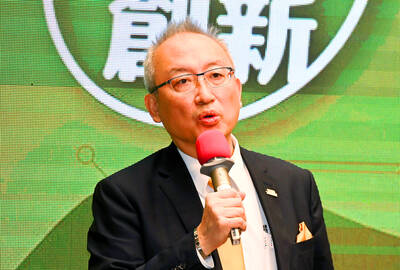The National Taiwan Museum yesterday introduced an augmented reality (AR) museum guide for its Natural History Branch in Taipei’s Zhongzheng District (中正).
The AR Museum Guide was jointly developed by the museum, the Ministry of Economic Affairs’ Industrial Development Bureau, Arplanet Digital Technology Co and Mr Fossil, the museum said.
With the guide, they hope to promote the development of the nation’s AR industry, it said.
It is the first time a museum in Taiwan has used an AR indoor positioning system to bring ancient organisms and fossils “back to life,” the museum said.
The AR technology has not only made the exhibits at the museum more lifelike, but also allows visitors to interact with them, providing more possibilities for popular science education, it said.
In the past, museum displays tended to be static, but due to the influence of electronic devices, museums worldwide have seen visitor numbers gradually decrease, museum director Hung Shih-yu (洪世佑) said.
To attract more visitors, the museum has over the past few years been committed to offering interactive shows, he said.
The launch of its AR guide is just the beginning, he said, adding that he believes in the future, and as technology becomes more sophisticated, museum visitors will have even more lively interactive experiences.
Describing the AR guide as trendsetting, Lin Chun-hsiu (林俊秀), a bureau representative, said that he hopes it encourages people to visit the museum more regularly.
Arplanet Digital Technology Co founder and chief executive officer Jennifer Pai (白璧珍) said that her team’s vision is that AR technology will become accessible to everyone, and become a part of people’s everyday lives.
The AR guide is the “first step” in AR experience at museums, she said, adding that she hopes it will “no longer be a dream” for everyone to experience AR.
The AR guide not only uses technology to add value to the museum’s collection, but also turns mobile devices into personal guides, the museum said, adding that it breathes new life into the museum’s educational efforts and visitor services.
Visitors to the museum’s Natural History Branch can use the AR guide by downloading the mobile app marq+.

Global bodies should stop excluding Taiwan for political reasons, President William Lai (賴清德) told Pope Francis in a letter, adding that he agrees war has no winners. The Vatican is one of only 12 countries to retain formal diplomatic ties with Taiwan, and Taipei has watched with concern efforts by Beijing and the Holy See to improve ties. In October, the Vatican and China extended an accord on the appointment of Catholic bishops in China for four years, pointing to a new level of trust between the two parties. Lai, writing to the pope in response to the pontiff’s message on Jan. 1’s

A Vietnamese migrant worker on Thursday won the NT$12 million (US$383,590) jackpot on a scratch-off lottery ticket she bought from a lottery shop in Changhua County’s Puyan Township (埔鹽), Taiwan Lottery Co said yesterday. The lottery winner, who is in her 30s and married, said she would continue to work in Taiwan and send her winnings to her family in Vietnam to improve their life. More Taiwanese and migrant workers have flocked to the lottery shop on Sec 2 of Jhangshuei Road (彰水路) to share in the luck. The shop owner, surnamed Chen (陳), said that his shop has been open for just

TAKE BREAKS: A woman developed cystitis by refusing to get up to use the bathroom while playing mahjong for fear of disturbing her winning streak, a doctor said People should stand up and move around often while traveling or playing mahjong during the Lunar New Year holiday, as prolonged sitting can lead to cystitis or hemorrhoids, doctors said. Yuan’s General Hospital urologist Lee Tsung-hsi (李宗熹) said that he treated a 63-year-old woman surnamed Chao (趙) who had been sitting motionless and holding off going to the bathroom, increasing her risk of bladder infection. Chao would drink beverages and not urinate for several hours while playing mahjong with friends and family, especially when she was on a winning streak, afraid that using the bathroom would ruin her luck, he said. She had

MUST REMAIN FREE: A Chinese takeover of Taiwan would lead to a global conflict, and if the nation blows up, the world’s factories would fall in a week, a minister said Taiwan is like Prague in 1938 facing Adolf Hitler; only if Taiwan remains free and democratic would the world be safe, Deputy Minister of Foreign Affairs Francois Wu (吳志中) said in an interview with Italian newspaper Corriere della Sera. The ministry on Saturday said Corriere della Sera is one of Italy’s oldest and most read newspapers, frequently covers European economic and political issues, and that Wu agreed to an interview with the paper’s senior political analyst Massimo Franco in Taipei on Jan. 3. The interview was published on Jan. 26 with the title “Taiwan like Prague in 1938 with Hitler,” the ministry